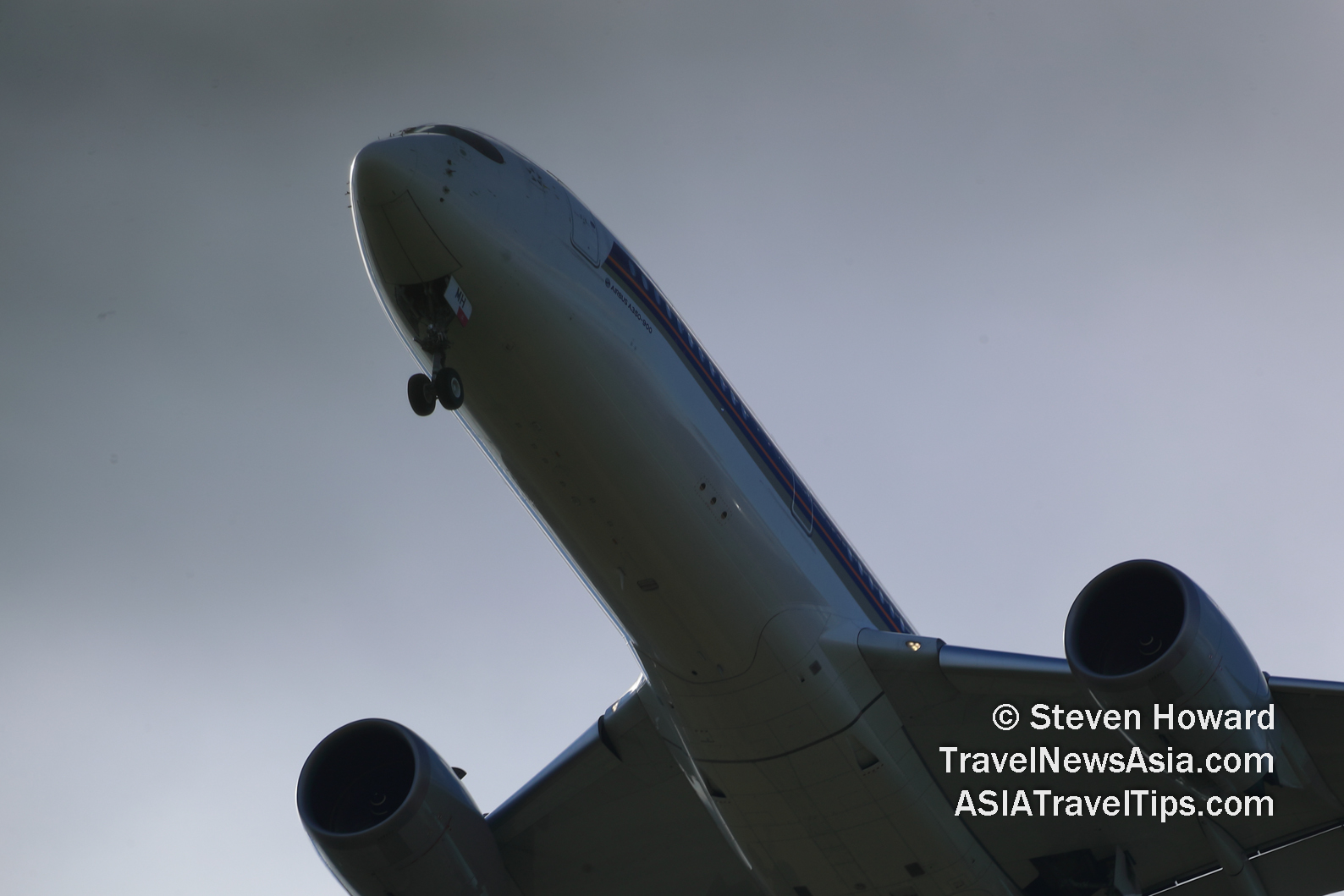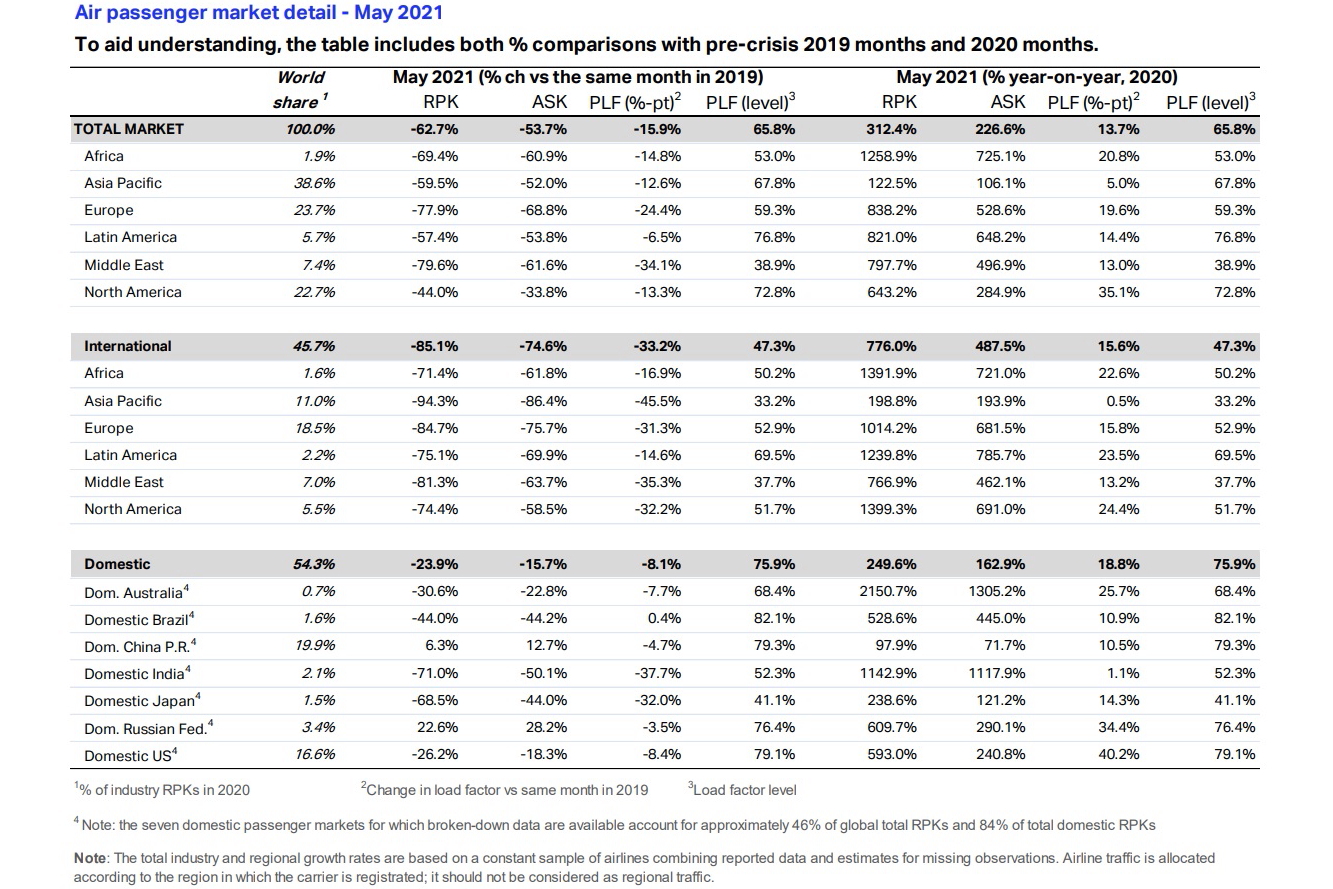|
According to IATA, both international and domestic travel demand showed
marginal improvements in May 2021 when compared to April, though
traffic remained well below pre-pandemic levels.
Recovery in international traffic in particular
continued to be stymied by extensive government travel
restrictions.
Total demand for air travel in May 2021, measured
in revenue passenger kilometers (RPKs), was down 62.7% when compared
to May 2019, a gain over the 65.2% decline recorded in
April 2021 versus April 2019.
International passenger demand in May was 85.1%
below May 2019, a small step-up from the 87.2% decline recorded in
April 2021 versus two years ago. All regions with the exception of
Asia-Pacific contributed to this modest improvement.

Total domestic demand was down 23.9% versus
pre-crisis levels (May 2019), slightly improved over April 2021,
when domestic traffic was down 25.5% versus the 2019 period.
China
and Russia traffic continue to be in in positive growth territory
compared to pre-COVID19 levels, while India and Japan saw
significant deterioration amid new variants and outbreaks.
�We are starting to see positive developments,
with some international markets opening to vaccinated travelers,�
said Willie Walsh, IATA�s Director General. �The Northern
Hemisphere summer travel season is now fully arrived. And it is
disappointing that more governments are not moving more rapidly to
use data to drive border opening strategies that would help revive
tourism jobs and reunite families.�
European carriers� May international traffic
declined 84.7% versus May 2019, improved from the 87.7% decrease
in April compared to the same month in 2019. Capacity dropped
75.7% and load factor fell 31.3 percentage points to 52.9%.

Asia-Pacific airlines saw their May international
traffic fall 94.3% compared to May 2019, fractionally worse than
the 94.2% drop registered in April 2021 versus April 2019. The
region experienced the steepest traffic declines for a tenth
consecutive month. Capacity was down 86.4% and the load factor
sank 45.5 percentage points to 33.2%, the lowest among regions.
Middle Eastern airlines experienced an 81.3%
demand drop in May compared to May 2019, slightly bettering the
82.9% decrease in April, versus the same month in 2019. Capacity
declined 63.7%, and load factor fell 35.3 percentage points to
37.7%.
North American carriers� May demand fell 74.4%
compared to the 2019 period, an improvement over the 77.6% decline
in April versus two years ago. Capacity sagged 58.5%, and load
factor dropped 32.2 percentage points to 51.7%.
Latin American airlines saw a 75.1% demand drop in
May, compared to the same month in 2019, notably improved over the
80.9% decline in April compared to April 2019. May capacity was
down 69.9% and load factor decreased 14.6 percentage points to
69.5%, which was the highest load factor among the regions for the
eighth consecutive month.
African airlines� traffic fell 71.4% in May versus
May two years ago, a gain from the 75.6% decline in April compared
to April 2019. May capacity declined 61.8% versus May 2019, and
load factor dropped 16.9 percentage points to 50.2%.
Domestic Passenger Markets
India�s domestic traffic fell 71.0% in May
compared to May 2019 amid the emergence of the new and more
contagious �Delta� variant. This compared to a 42% decline
registered in April versus the same month two years ago.
Brazil�s domestic traffic rebounded from a 60.9%
decline in April versus the same month in 2019, to a 44% decline
in May, as travel restrictions were eased.
Vaccinated Travelers Pose Very
Little Risk to Local Populations
�To paraphrase an old saying, when you think that
all you have is a hammer, every problem looks like a nail. Too
many governments continue to act as if the only tool in their
anti-COVID19 arsenal is a blanket border closure or an arrival
quarantine. In fact, research from leading medical organizations
around the globe confirms that vaccinated travelers pose very
little risk to the local population while data show that
pre-departure testing largely removes the risk of unvaccinated
travelers importing COVID19,� said Walsh. �It is long past time
for governments to start responding to this information with more
nuanced data-driven risk-based strategies. These will minimize the
chance of importing COVID19 while allowing the world to reopen to
travel and all the opportunities it brings to reconnect with loved
ones, to realize business opportunities, to explore the world or
take a well-deserved vacation.�
The complete Air Passenger Market Analysis for May
2021 can be downloaded in .pdf format
here.
Note: Because comparisons between 2021 and 2020 monthly
results are distorted by the extraordinary impact of COVID19,
unless otherwise noted all comparisons above are to May 2019, which
followed a normal demand pattern.
See also:
What is the IATA Travel Pass, and what does it mean for
travellers, airlines and the global travel industry? Exclusive
video interview with Vinoop Goel.
See latest
Travel Industry News,
Video
Interviews,
Podcasts
and other
news regarding:
IATA,
RPK,
ASK,
Traffic.
|
Headlines: |
|
|
